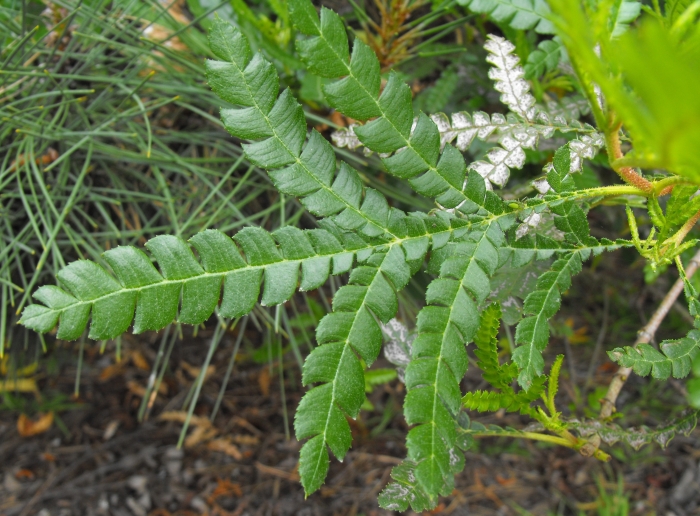Catalina Ironwood
(Lyonothamnus floribundus)
Catalina Ironwood (Lyonothamnus floribundus)
/
/

Stickpen
Public domain
Image By:
Stickpen
Recorded By:
Copyright:
Public domain
Copyright Notice:
Photo by: Stickpen | License Type: Public domain | License URL: https://creativecommons.org/public-domain/ | Uploader: Stickpen | Publisher: Wikimedia Commons | Title: Lyonothamnusfloribundusasp.jpg | Notes: Transferred from Flickr by [[User:AlbertHerring]] |










































Estimated Native Range
Summary
Lyonothamnus floribundus, commonly known as Catalina Ironwood, is an evergreen tree primarily found in the cloud forests and canyons of the Channel Islands off the coast of California. It can grow up to 15 meters (49 ft) tall and is characterized by its peeling reddish-gray or brown bark. The leaves are shiny, dark green with lighter undersides, and vary in shape between the two subspecies. The tree is notable for its inflorescence, which consists of clusters of woolly white flowers with numerous short, whiskery stamens, blooming in late spring to early summer. The fruit is a pair of hard follicles, and the tree is known to form distinct groves on the islands, with each grove being a clonal colony.
Catalina Ironwood is valued for its unique appearance and adaptability to drought conditions, making it suitable for California native plant gardens, wildlife habitats, and water-wise landscapes. It is also used in urban settings for its ornamental bark and foliage. This species requires full sun and well-drained soils, and it is tolerant of low water conditions once established. It is important to note that while it is drought-tolerant, it thrives with occasional deep watering during prolonged dry periods. Potential problems include susceptibility to fungal diseases in poorly drained soils.CC BY-SA 4.0
Catalina Ironwood is valued for its unique appearance and adaptability to drought conditions, making it suitable for California native plant gardens, wildlife habitats, and water-wise landscapes. It is also used in urban settings for its ornamental bark and foliage. This species requires full sun and well-drained soils, and it is tolerant of low water conditions once established. It is important to note that while it is drought-tolerant, it thrives with occasional deep watering during prolonged dry periods. Potential problems include susceptibility to fungal diseases in poorly drained soils.CC BY-SA 4.0
Plant Description
- Plant Type: Tree
- Height: 35-40 feet
- Width: 15-20 feet
- Growth Rate: Moderate
- Flower Color: White
- Flowering Season: Spring, Summer
- Leaf Retention: Evergreen
Growth Requirements
- Sun: Full Sun
- Water: Low
- Drainage: Fast, Medium
Common Uses
Drought Tolerant, Low Maintenance, Salt Tolerant, Showy Flowers
Natural Habitat
Cloud forests and canyons of the Channel Islands
Other Names
Common Names:
Scientific Names: , Lyonothamnus floribundus, Llyonothamnus floribundus, Llyonothamnus floribundus var. floribundus,
GBIF Accepted Name: Lyonothamnus floribundus A.Gray